Trump Proves Once Again He Has
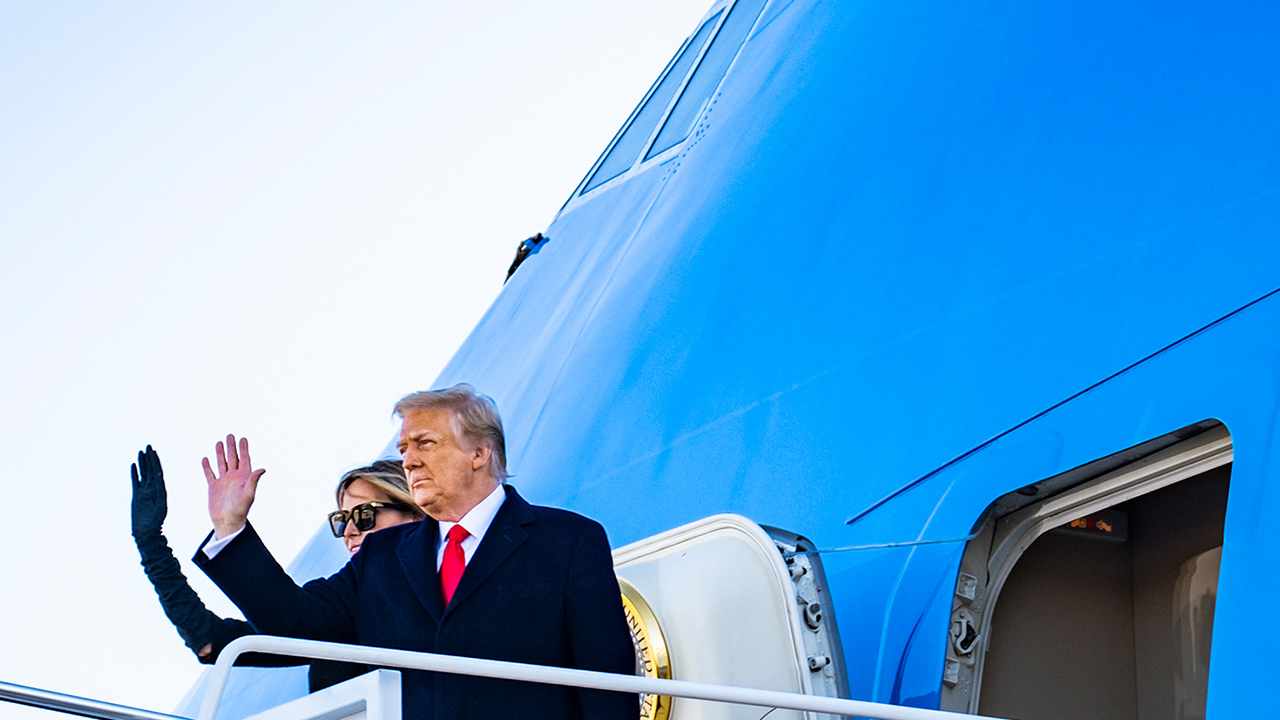
How America Changed During Donald Trump's Presidency
Donald Trump stunned the political globe in 2016 when he became the get-go person without authorities or military feel ever to be elected president of the United States. His 4-twelvemonth tenure in the White Firm revealed extraordinary fissures in American society but left little doubt that he is a figure dissimilar whatsoever other in the nation'due south history.
Trump, the New York businessman and former reality TV show star, won the 2016 election later a campaign that defied norms and allowable public attention from the moment information technology began. His approach to governing was equally unconventional.
Other presidents tried to unify the nation after turning from the campaign trail to the White House. From his beginning days in Washington to his last, Trump seemed to revel in the political fight. He used his presidential megaphone to criticize a long list of perceived adversaries, from the news media to members of his ain assistants, elected officials in both political parties and foreign heads of state. The more 26,000 tweets he sent as president provided an unvarnished, existent-time account of his thinking on a broad spectrum of issues and eventually proved then provocative that Twitter permanently banned him from its platform. In his terminal days in function, Trump became the first president ever to be impeached twice – the 2nd time for inciting an insurrection at the U.Due south. Capitol during the certification of the election he lost – and the nation'south first chief executive in more than 150 years to decline to nourish his successor's inauguration.
Trump's policy record included major changes at home and abroad. He achieved a string of long-sought conservative victories domestically, including the biggest corporate tax cuts on record, the elimination of scores of environmental regulations and a reshaping of the federal judiciary. In the international arena, he imposed tough new immigration restrictions, withdrew from several multilateral agreements, forged closer ties with State of israel and launched a tit-for-tat trade dispute with Mainland china as office of a wider try to address what he saw as glaring imbalances in America's economic relationship with other countries.
Many questions about Trump'due south legacy and his role in the nation'southward political future volition take fourth dimension to answer. Just some takeaways from his presidency are already clear from Pew Research Eye'south studies in recent years. In this essay, we take a closer look at a few of the key societal shifts that accelerated – or emerged for the first time – during the tenure of the 45th president.
Related: How America Changed During Barack Obama's Presidency
This examination of how the United States inverse during Donald Trump's presidency is based on an assay of public stance survey information from Pew Research Center, administrative data from authorities agencies, news reports and other sources. Links to the original sources of information – including the field dates, sample sizes and methodologies of individual surveys by the Center – are included wherever possible. Unless otherwise noted, all references to Republicans and Democrats in this analysis include independents who lean to each party.
Deeply partisan and personal divides
Trump'due south condition as a political outsider, his outspoken nature and his willingness to upend past customs and expectations of presidential behavior fabricated him a constant focus of public attending, every bit well every bit a source of deep partisan divisions.
Fifty-fifty before he took function, Trump divided Republicans and Democrats more than than whatsoever incoming chief executive in the prior iii decades.1 The gap but grew more than pronounced after he became president. An boilerplate of 86% of Republicans canonical of Trump's treatment of the job over the course of his tenure, compared with an average of just half-dozen% of Democrats – the widest partisan gap in approving for any president in the modernistic era of polling.two Trump's overall approval rating never exceeded 50% and fell to a low of just 29% in his final weeks in part, shortly after a mob of his supporters attacked the Capitol.
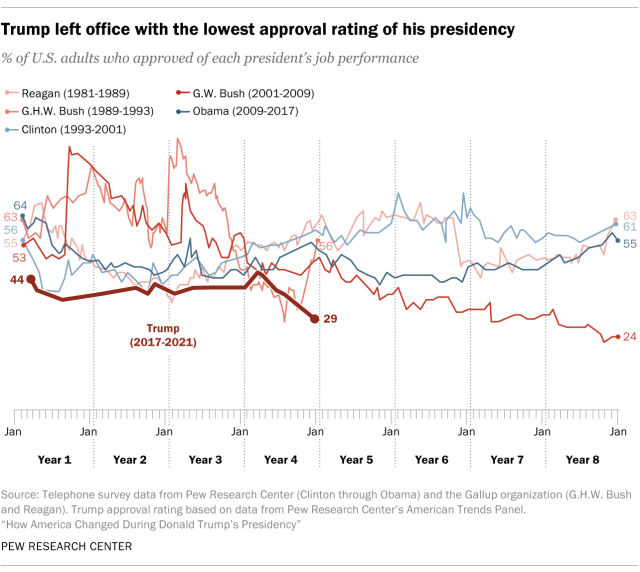
Republicans and Democrats weren't but divided over Trump'south handling of the job. They besides interpreted many aspects of his character and personality in fundamentally reverse ways. In a 2019 survey, at least three-quarters of Republicans said the president'south words sometimes or often made them experience hopeful, entertained, informed, happy and proud. Even larger shares of Democrats said his words sometimes or oft made them feel concerned, exhausted, aroused, insulted and confused.
The strong reactions that Trump provoked appeared in highly personal contexts, likewise. In a 2019 survey, 71% of Democrats who were unmarried and looking for a relationship said they would definitely or probably non consider being in a committed relationship with someone who had voted for Trump in 2016. That far exceeded the 47% of single-and-looking Republicans who said they would not consider beingness in a serious relationship with a Hillary Clinton voter.
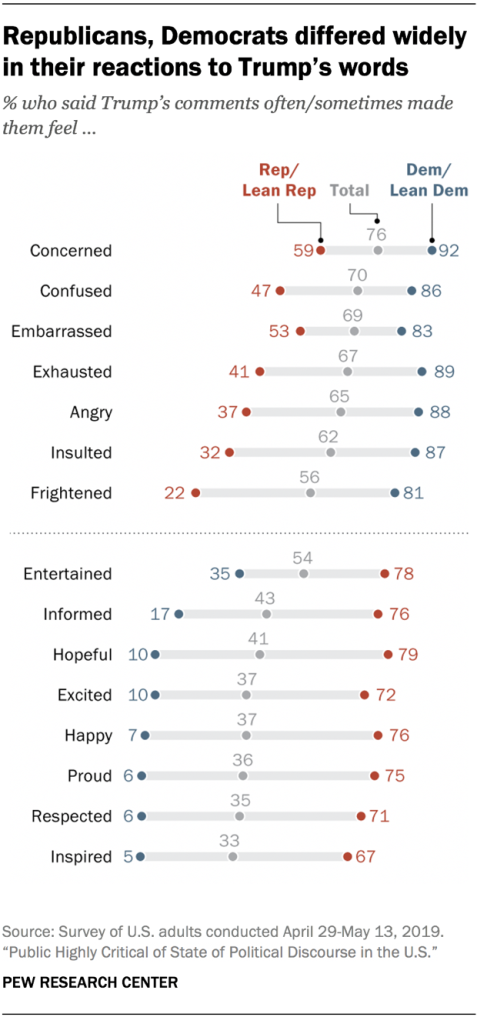
Many Americans opted non to talk virtually Trump or politics at all. In 2019, almost half of U.S. adults (44%) said they wouldn't feel comfortable talking about Trump with someone they didn't know well. A like share (45%) said later that year that they had stopped talking politics with someone because of something that person had said.
In addition to the intense divisions that emerged over Trump personally, his tenure saw a further widening of the gulf between Republicans and Democrats over cadre political values and issues, including in areas that weren't specially partisan earlier his inflow.
In 1994, when Pew Research Eye began request Americans a series of 10 "values questions" on subjects including the part of government, environmental protection and national security, the average gap between Republicans and Democrats was fifteen percentage points. By 2017, the first year of Trump'southward presidency, the average partisan gap on those same questions had more than doubled to 36 points, the result of a steady, decades-long increase in polarization.
On some issues, there were bigger changes in thinking among Democrats than among Republicans during Trump'south presidency. That was especially the example on topics such equally race and gender, which gained new attention amongst the Black Lives Matter and #MeToo movements. In a 2020 survey that followed months of racial justice protests in the U.Southward., for instance, 70% of Democrats said it is "a lot more difficult" to be a Blackness person than to be a White person in the U.Due south. today, upwardly from 53% who said the same thing only four years earlier. Republican attitudes on the same question changed niggling during that span, with simply a small share like-minded with the Democratic view.
On other issues, attitudes inverse more among Republicans than among Democrats. Ane notable example related to views of higher education: Between 2015 and 2017, the share of Republicans who said colleges and universities were having a negative effect on the way things were going in the U.S. rose from 37% to 58%, fifty-fifty equally around seven-in-ten Democrats continued to say these institutions were having a positive result.
Related: From #MAGA to #MeToo: A Look at U.Southward. Public Opinion in 2017
A dearth of shared facts and information
One of the few things that Republicans and Democratscouldconcord on during Trump's tenure is that they didn't share the same set of facts. In a 2019 survey, around three-quarters of Americans (73%) said near Republican and Democratic voters disagreed not but over political plans and policies, but over "basic facts."
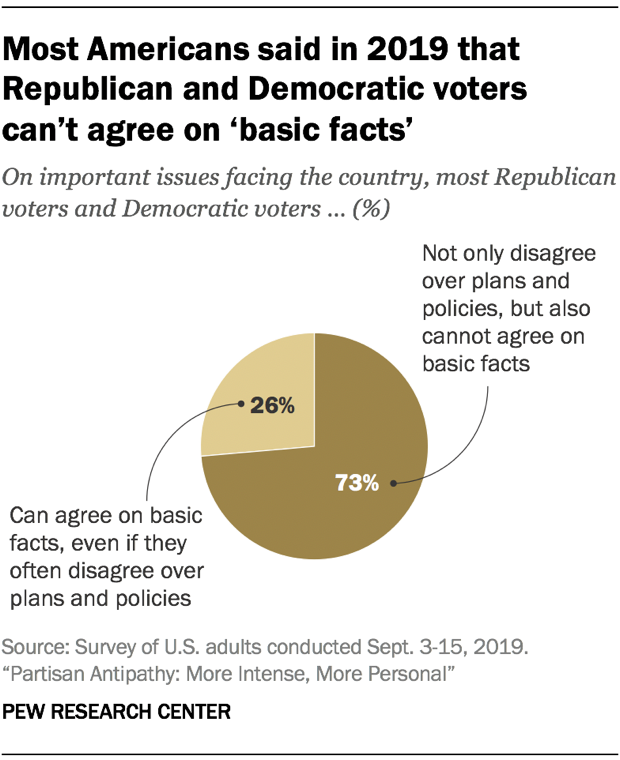
Much of the disconnect betwixt the parties involved the news media, which Trump routinely disparaged as "faux news" and the "enemy of the people." Republicans, in particular, expressed widespread and growing distrust of the printing. In a 2019 survey, Republicans voiced more distrust than trust in 2o of the 30 specific news outlets they were asked about, even as Democrats expressed more trust than distrust in 22 of those same outlets. Republicans overwhelmingly turned to and trusted one outlet included in the written report – Fox News – even as Democrats used and expressed trust in a wider range of sources. The study concluded that the two sides placed their trust in "two nearly changed media environments."
Some of the media organizations Trump criticized near vocally saw the biggest increases in GOP distrust over time. The share of Republicans who said they distrusted CNN rose from 33% in a 2014 survey to 58% by 2019. The proportion of Republicans who said they distrusted The Washington Post and The New York Times rose 17 and 12 percent points, respectively, during that span.iii
In addition to their criticisms of specific news outlets, Republicans also questioned the broader motives of the media. In surveys fielded over the form of 2018 and 2019, Republicans were far less likely than Democrats to say that journalists deed in the best interests of the public, take loftier ethical standards, prevent political leaders from doing things they shouldn't and bargain fairly with all sides. Trump'south staunchest GOP supporters oft had the almost negative views: Republicans who strongly canonical of Trump, for instance, were much more than likely than those who just somewhat approved or disapproved of him to say journalists accept very low ethical standards.
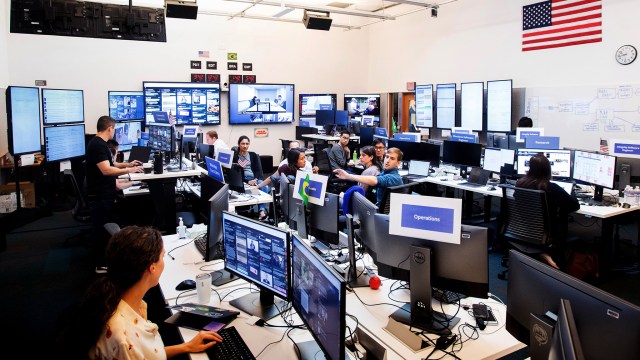
Apart from the growing partisan polarization over the news media, Trump'southward time in role also saw the emergence of misinformation as a concerning new reality for many Americans.
Half of U.Southward. adults said in 2019 that fabricated-upward news and data was a very big problem in the state, exceeding the shares who said the same thing about racism, illegal clearing, terrorism and sexism. Effectually ii-thirds said made-up news and information had a big affect on public confidence in the government (68%), while half or more said it had a major effect on Americans' confidence in each other (54%) and political leaders' ability to get work done (51%).
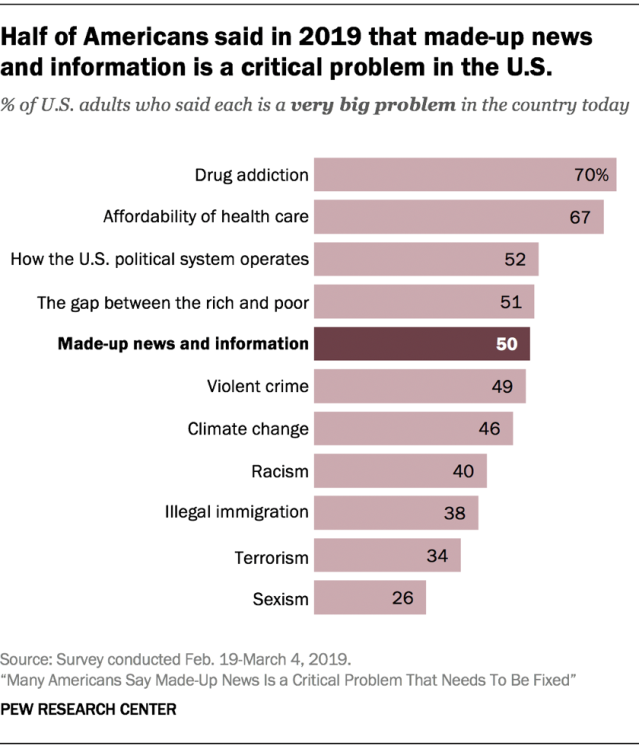
Misinformation played an important role in both the coronavirus pandemic and the 2020 presidential election. Almost two-thirds of U.Due south. adults (64%) said in April 2020 that they had seen at least some fabricated-up news and information virtually the pandemic, with around one-half (49%) maxim this kind of misinformation had acquired a nifty deal of defoliation over the basic facts of the outbreak. In a survey in mid-Nov 2020, 6-in-ten adults said made-up news and information had played a major role in the only-concluded election.
Conspiracy theories were an especially salient form of misinformation during Trump's tenure, in many cases amplified by the president himself. For example, nearly half of Americans (47%) said in September 2020 that they had heard or read a lot or a piddling nearly the collection of conspiracy theories known equally QAnon, up from 23% earlier in the year.four Nigh of those aware of QAnon said Trump seemed to support the theory'southward promoters.
Trump frequently made disproven or questionable claims as president. News and fact-checking organizations documented thousands of his false statements over iv years, on subjects ranging from the coronavirus to the economy. Perchance none were more consequential than his repeated assertion of widespread fraud in the 2020 election he lost to Democrat Joe Biden. Fifty-fifty after courts around the country had rejected the claim and all fifty states had certified their results, Trump continued to say he had won a "landslide" victory. The false claim gained widespread currency among his voters: In a January 2021 survey, 3-quarters of Trump supporters incorrectly said he was definitely or probably the rightful winner of the election.
New concerns over American democracy
Throughout his tenure, Donald Trump questioned the legitimacy of democratic institutions, from the free press to the federal judiciary and the electoral process itself. In surveys conducted between 2016 and 2019, more than half of Americans said Trump had niggling or no respect for the nation's autonomous institutions and traditions, though these views, likewise, split sharply along partisan lines.
The 2020 election brought concerns about democracy into much starker relief. Fifty-fifty before the election, Trump had cast doubt on the security of mail-in voting and refused to commit to a peaceful transfer of power in the event that he lost. When he did lose, he refused to publicly concede defeat, his campaign and allies filed dozens of unsuccessful lawsuits to claiming the results and Trump personally pressured state authorities officials to retroactively tilt the outcome in his favor.
The weeks of legal and political challenges culminated on Jan. half-dozen, 2021, when Trump addressed a oversupply of supporters at a rally outside the White House and again falsely claimed the ballot had been "stolen." With Congress meeting the same day to certify Biden's win, Trump supporters stormed the Capitol in an attack that left five people dead and forced lawmakers to exist evacuated until order could be restored and the certification could be completed. The House of Representatives impeached Trump a week afterward on a charge of inciting the violence, with 10 Republicans joining 222 Democrats in back up of the decision.
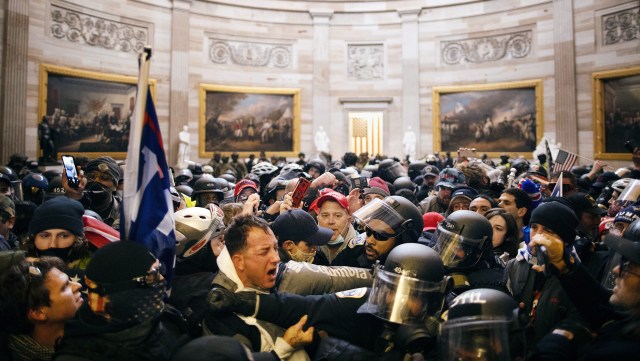
Most Americans placed at least some blame on Trump for the riot at the Capitol, including 52% who said he bore a lot of responsibleness for it. Once again, however, partisans' views differed widely: 81% of Democrats said Trump bore a lot of responsibility, compared with just 18% of Republicans.
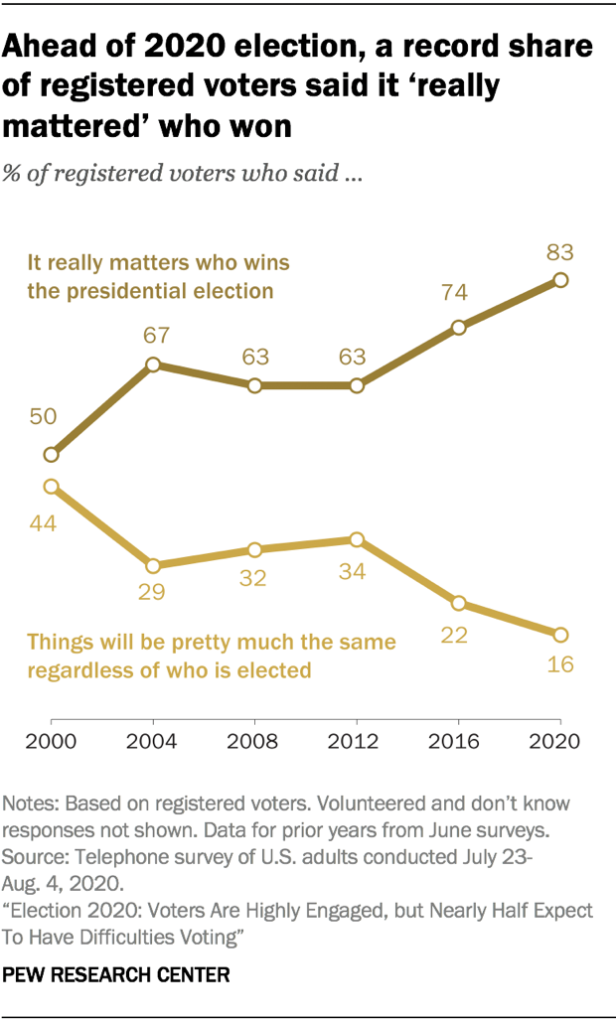
Fifty-fifty as he repeatedly bandage doubtfulness on the democratic process, Trump proved to exist an enormously galvanizing figure at the polls. About 160 meg Americans voted in 2020, the highest estimated turnout charge per unit amongst eligible voters in 120 years, despite widespread changes in voting procedures brought on by the pandemic. Biden received more than 81 million votes and Trump received more than than 74 one thousand thousand, the highest and 2nd-highest totals in U.S. history. Turnout in the 2018 midterm election, the first afterward Trump took role, also set a modern-day record.
Pew Enquiry Center surveys catalogued the loftier stakes that voters perceived, particularly in the run-up to the 2020 election. Simply before the election, effectually nine-in-ten Trump and Biden supporters said in that location would be "lasting harm" to the nation if the other candidate won, and around eight-in-x in each group said they disagreed with the other side non just on political priorities, but on "core American values and goals."
Earlier in the year, 83% of registered voters said it "really mattered" who won the election, the highest percent for whatever presidential election in at least ii decades. Trump himself was a clear motivating factor for voters on both sides: 71% of Trump supporters said before the ballot that their selection was more than of a votefor the president than against Biden, while 63% of Biden supporters said their choice was more of a voteagainst Trump than for his opponent.
A reckoning over racial inequality
Racial tensions were a constant undercurrent during Trump's presidency, oft intensified by the public statements he fabricated in response to high-contour incidents.
The death of George Floyd, in particular, brought race to the surface in a way that few other recent events have. The videotaped killing of the unarmed, 46-year-old Black man by a White constabulary officeholder in Minneapolis was amidst several law killings that sparked national and international protests in 2020 and led to an outpouring of public back up for the Blackness Lives Matter movement, including from corporations, universities and other institutions. In a survey shortly afterward Floyd'due south expiry in May, two-thirds of U.S. adults – including majorities beyond all major racial and ethnic groups – voiced support for the movement, and apply of the #BlackLivesMatter hashtag surged to a tape high on Twitter.
Attitudes began to change as the protests wore on and sometimes turned violent, cartoon sharp condemnation from Trump. Past September, back up for the Black Lives Matter movement had slipped to 55% – largely due to decreases among White adults – and many Americans questioned whether the nation's renewed focus on race would lead to changes to accost racial inequality or better the lives of Blackness people.
Race-related tensions erupted into public view before in Trump's tenure, besides. In 2017, White nationalists rallied in Charlottesville, Virginia, to protest the removal of a Confederate statue amidst a broader push to eliminate such memorials from public spaces across the land. The rally led to tearing clashes in the city's streets and the death of a 32-year-old woman when a White nationalist deliberately drove a car into a oversupply of people. Tensions too arose in the National Football League as some players protested racial injustices in the U.S. past kneeling during the national anthem. The display prompted a backfire amongst some who saw it as disrespectful to the American flag.
In all of these controversies and others, Trump weighed in from the White House, but typically not in a way that most Americans saw equally helpful. In a summer 2020 survey, for instance, six-in-ten U.S. adults said Trump had delivered the wrong message in response to the protests over Floyd'south killing. That included around iv-in-ten adults (39%) who said Trump had delivered thecompletely incorrect message.
More broadly, Americans viewed Trump's impact on race relations as far more than negative than positive. In an early on 2019 poll, 56% of adults said Trump had made race relations worse since taking office, compared with only 15% who said he had made progress toward improving relations. In the same survey, effectually 2-thirds of adults (65%) said it had go more common for people in the U.S. to express racist or racially insensitive views since his election.
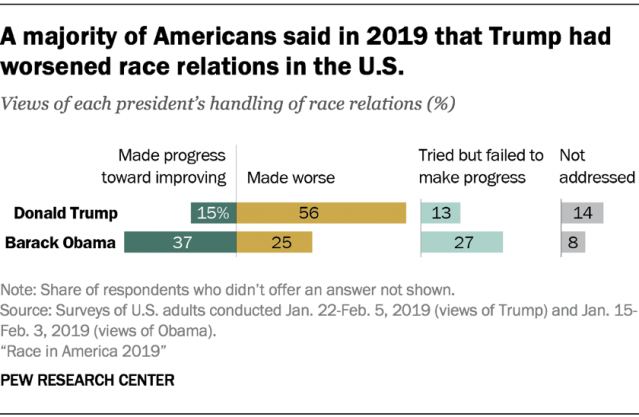
The public as well perceived Trump equally as well close with White nationalist groups. In 2019, a bulk of adults (56%) said he had done too little to distance himself from these groups, while 29% said he had done near the right amount and vii% said he had washed too much. These opinions were nearly the same equally in Dec 2016, before he took office.
While Americans overall gave Trump much more than negative than positive marks for his handling of race relations, in that location were consistent divisions along racial, indigenous and partisan lines. Black, Hispanic and Asian adults were often more critical of Trump's bear on on race relations than White adults, as were Democrats when compared with Republicans. For example, while an overwhelming bulk of Democrats (83%) said in 2019 that Trump had done too piffling to distance himself from White nationalist groups, a majority of Republicans (56%) said he had done about the right amount.
White Republicans, in detail, rejected the idea of widespread structural racism in the U.S. and saw likewise much accent on race. In September 2020, around eight-in-x White Republicans (79%) said the bigger trouble was people seeing racial discrimination where it doesn't exist, rather than people non seeing discrimination where information technology really does exist. The opinions of White Democrats on the same question were nearly the reverse.
A defining public health and economic crunch
Every presidency is shaped by outside events, and Trump'southward will undoubtedly exist remembered for the enormous toll the coronavirus pandemic took on the nation's public wellness and economy.
More than than 400,000 Americans died from COVID-19 betwixt the first of the pandemic and when Trump left office, with fatality counts sometimes exceeding iv,000 people a day – a toll more than severe than theoverall price of the terrorist attacks of Sept. xi, 2001, or the bombing of Pearl Harbor on Dec. 7, 1941. Trump himself contracted the coronavirus in the home stretch of his campaign for reelection, equally did dozens of White House and entrada staff and members of his family unit.
The far-reaching public health furnishings of the virus were reflected in a survey in November 2020, when more than than half of U.Due south. adults (54%) said they personally knew someone who had been hospitalized or died due to COVID-19. The shares were fifty-fifty higher amid Black (71%) and Hispanic (61%) adults.
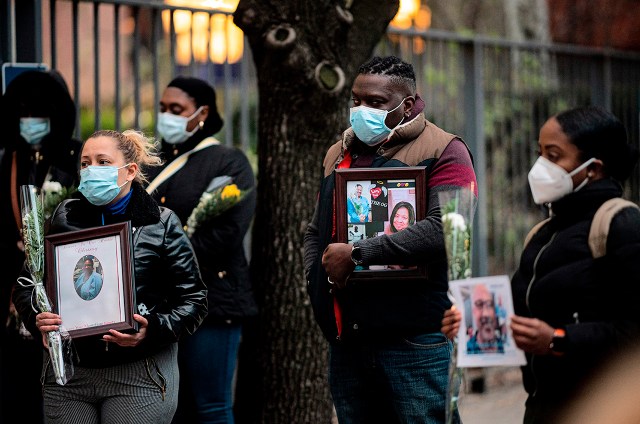
At the same time, the pandemic had a disastrous effect on the economic system. Trump and Barack Obama together had presided over the longest economic expansion in American history, with the U.S. unemployment rate at a 50-year low of 3.5% every bit recently as Feb 2020. By April 2020, with businesses effectually the land endmost their doors to prevent the spread of the virus, unemployment had soared to a post-World War II high of 14.eight%. Even later on considerable employment gains later in the year, Trump was the first modern president to leave the White Firm with fewer jobs in the U.S. than when he took office.
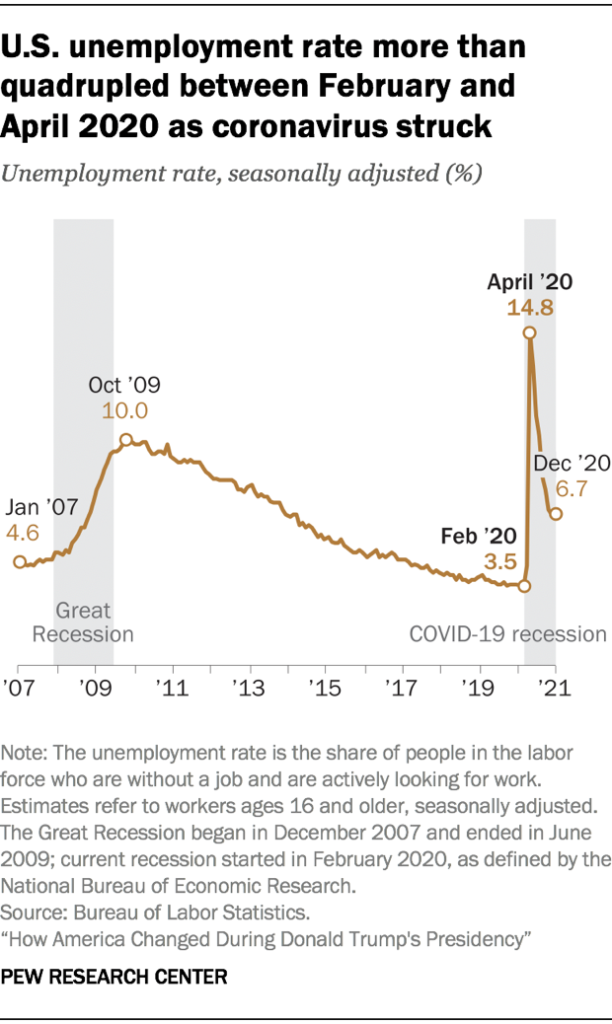
The economic consequences of the virus, like its public health repercussions, hit some Americans harder than others. Many upper-income workers were able to continue doing their jobs remotely during the outbreak, even as lower-income workers suffered widespread task losses and pay cuts. The remarkable resiliency of U.S. stock markets was a rare bright spot during the downturn, but ane that had its own implications for economic inequality: Going into the outbreak, upper-income adults were far more than likely than lower-income adults to be invested in the market.
The pandemic clearly underscored and exacerbated America's partisan divisions. Democrats were consistently much more likely than Republicans to see the virus as a major threat to public health, while Republicans were far more than likely than Democrats to see it equally exaggerated and overblown. The ii sides disagreed on public health strategies ranging from mask wearing to contact tracing.
The outbreak besides had important consequences for America'due south paradigm in the world. International views of the U.South. had already plummeted subsequently Trump took office in 2017, but attitudes turned fifty-fifty more negative among a widespread perception that the U.S. had mishandled the initial outbreak. The share of people with a favorable stance of the U.S. roughshod in 2020 to record or about-record lows in Canada, French republic, Federal republic of germany, Japan, the Great britain and other countries. Across all 13 nations surveyed, a median of only xv% of adults said the U.S. had done a good chore responding to COVID-nineteen, well beneath the median share who said the same thing about their ain country, the World Health Organization, the European Wedlock and People's republic of china.
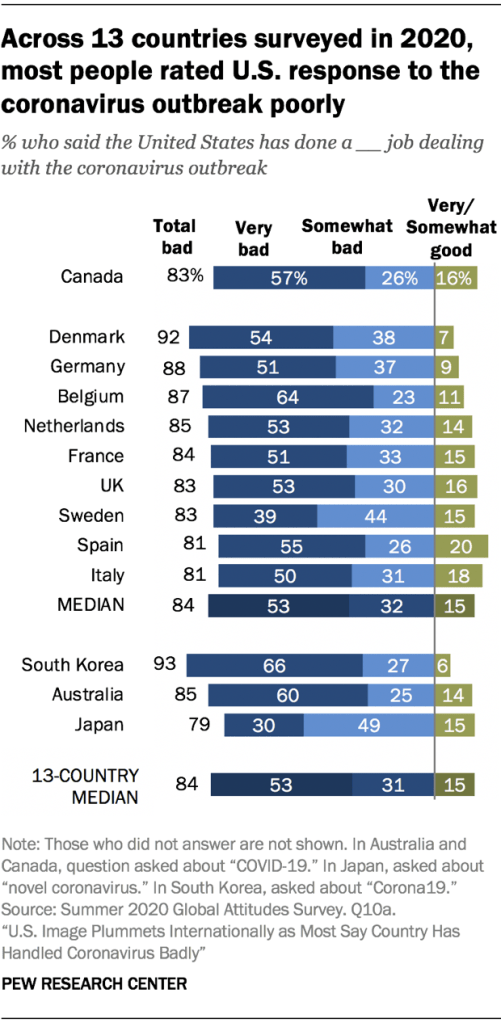
At a much more than personal level, many Americans expected the coronavirus outbreak to have a lasting impact on them. In an Baronial 2020 survey, 51% of U.S. adults said they expected their lives to remain changed in major ways fifty-fifty after the pandemic is over.
Looking ahead
The aftershocks of Donald Trump's one-of-a-kind presidency will take years to place into full historical context. It remains to be seen, for example, whether his disruptive brand of politics volition be adopted by other candidates for office in the U.S., whether other politicians tin can actuate the same coalition of voters he energized and whether his positions on gratis merchandise, immigration and other issues will be reflected in regime policy in the years to come.
Some of the near pressing questions, particularly in the aftermath of the attack on the Capitol and Trump's subsequent bipartisan impeachment, business organization the future of the Republican Party. Some Republicans have moved away from Trump, only many others take continued to fight on his behalf, including by voting to reject the balloter votes of two states won by Biden.
The GOP'due south direction could depend to a considerable caste on what Trump does next. Effectually ii-thirds of Americans (68%) said in Jan 2021 that they wouldnon like to meet Trump continue to be a major political effigy in the years to come, but Republicans were divided by credo. More than half of cocky-described moderate and liberal Republicans (56%) said they preferred for him to exit the political phase, while 68% of conservatives said they wanted him to remain a national political effigy for many years to come up.
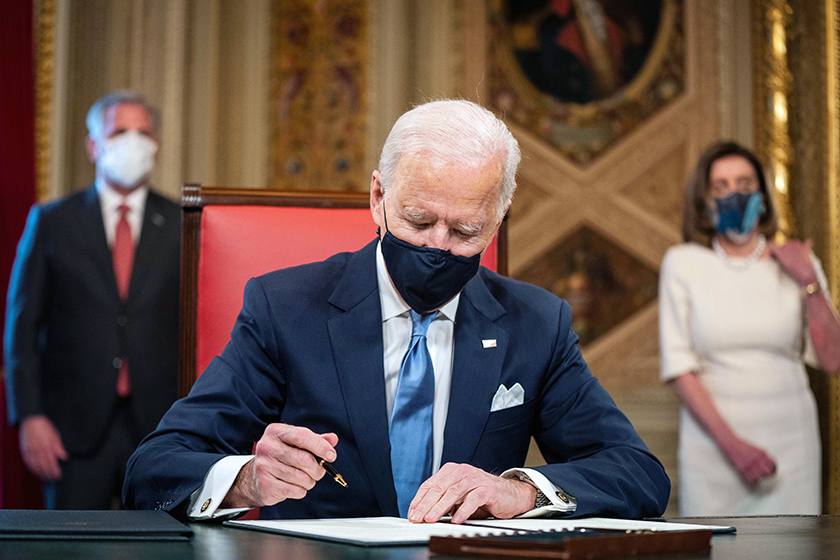
For his role, Joe Biden has some advantages as he begins his tenure. Democrats accept majorities – albeit extraordinarily narrow ones – in both legislative chambers of Congress. Other recent periods of single-party control in Washington have resulted in the enactment of major legislation, such equally the $1.5 trillion tax cut package that Trump signed in 2017 or the wellness care overhaul that Obama signed in 2010. Biden begins his presidency with by and large positive assessments from the American public almost his Cabinet appointments and the chore he has done explaining his policies and plans for the time to come. Early surveys show that he inspires wide confidence amidst people in 3 European countries that have long been important American allies: France, Germany and the United kingdom.
Withal, the new administration faces obvious challenges on many fronts. The coronavirus pandemic volition continue in the months ahead as the vast majority of Americans remain unvaccinated. The economic system is likely to struggle until the outbreak is under control. Polarization in the U.Southward. is not likely to change dramatically, nor is the partisan gulf in views of the news media or the spread of misinformation in the age of social media. The global challenges of climate change and nuclear proliferation remain stark.
The nation's 46th president has vowed to unite the country every bit he moves frontward with his policy agenda. Few would question the formidable nature of the task.
Title photograph: President Donald Trump and offset lady Melania Trump lath Air Force Ane for his last time as president on January. 20, 2021. (Pete Marovich–Pool/Getty Images)
Source: https://www.pewresearch.org/2021/01/29/how-america-changed-during-donald-trumps-presidency/
Post a Comment for "Trump Proves Once Again He Has"